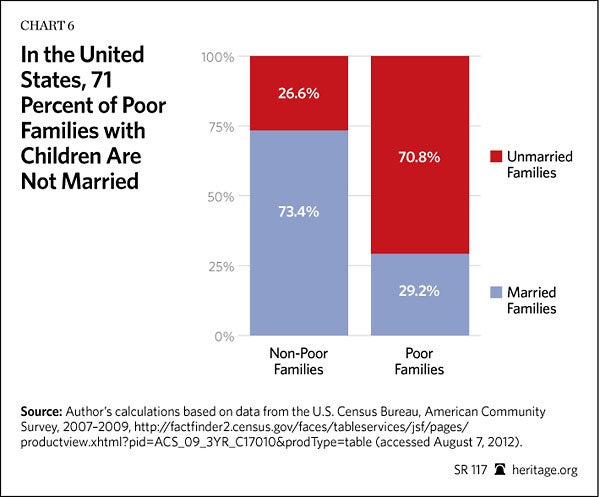The collapse of marriage, along with a dramatic rise in births to single women, is the most important cause of childhood poverty—but government policy doesn’t reflect that reality, according to a special report released today by The Heritage Foundation.
Nearly three out of four poor families with children in America are headed by single parents. When a child’s father is married to his mother, however, the probability of the child’s living in poverty drops by 82 percent.
Robert Rector, Heritage’s senior research fellow in domestic policy, provides a brief overview of each state with unique data and 14 charts per state, while also updating his years of related research in the special report titled “Marriage: America’s Greatest Weapon Against Child Poverty.” Heritage’s study, including a national charts slideshow, arrives a week before the Census Bureau’s annual report on poverty, which is expected to show another increase.
“Policymakers on the state and national levels recognize that education reduces poverty, but they’re largely unaware that marriage is an equally strong anti-poverty weapon,” says Rector, a nationally recognized authority on the U.S. welfare system. (continues below chart)
In Florida, for example, white families headed by single parents are five times more likely to be poor than those headed by married couples. In Illinois, the poverty rate for a single mother with only a high school diploma is 39.5 percent, compared with 8 percent for a married couple with the same education.
The rate of births to unmarried women—now four out of every 10 babies overall, five out of 10 for Hispanics, and seven out of 10 for blacks—has soared since the mid-1960s, when President Lyndon Johnson launched the War on Poverty. Births outside marriage are mostly to less-educated women—sadly, those with the least ability to support children.
While more Americans grow dependent on welfare, government fails to communicate the benefits of marriage even as it warns young people not to smoke, do drugs, have “unsafe” sex, or drop out of school. Rector calls this “tragic.”
Well over a third of all single-parent families with children (37 percent) were poor in 2009. Only 6.8 percent of married couples with children were poor. Marriage reduces the probability of poverty for all racial groups.
Rector finds a silver lining: Most unmarried moms—and dads, too—do look favorably on marriage. “New policies should be developed that build on these attitudes,” he says. Specifically, government should:
- Provide facts to at-risk youth about the value of marriage;
- Connect low-income couples with community resources that teach them the skills they need to build lasting marriages before having children; and
- Reform the welfare system to encourage rather than discourage and penalize marriage.



























